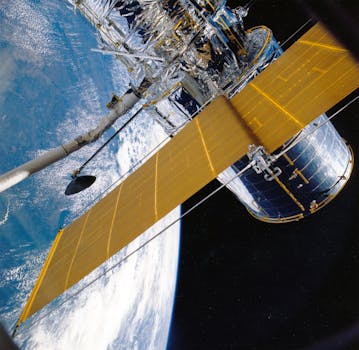
GEO Satellites: Understanding the Technology and its Applications
GEO satellites, or Geostationary Earth Orbit satellites, are a type of satellite that orbits the Earth at an altitude of approximately 36,000 kilometers. They are stationed above the equator and remain in a fixed position relative to the Earth’s surface, providing continuous coverage of a specific region. GEO satellites play a crucial role in modern telecommunications, enabling global communication, navigation, and remote sensing.
GEO satellites are equipped with transponders that receive and retransmit signals, allowing them to communicate with Earth stations and other satellites. They are used for a wide range of applications, including telecommunications, broadcasting, weather forecasting, and navigation. The technology behind GEO satellites is complex and involves careful planning and execution to ensure that the satellite remains in its designated orbit and functions correctly.
The History of GEO Satellites
The concept of GEO satellites was first proposed by science fiction writer Arthur C. Clarke in 1945. The first GEO satellite, Syncom 2, was launched in 1963 by NASA. Since then, numerous GEO satellites have been launched, with many countries and organizations operating their own fleets of satellites. Today, GEO satellites are a critical component of modern telecommunications, providing global coverage and enabling a wide range of applications.
The development of GEO satellites has been driven by advances in technology, including improvements in rocketry, materials science, and electronics. The first GEO satellites were relatively simple, with limited capabilities and short lifetimes. However, modern GEO satellites are highly sophisticated, with advanced transponders, propulsion systems, and power sources. They are designed to operate for 15 years or more, providing continuous service and requiring minimal maintenance.
Applications of GEO Satellites
GEO satellites have a wide range of applications, including telecommunications, broadcasting, weather forecasting, and navigation. They are used by governments, corporations, and individuals to communicate with each other and to access information. GEO satellites are also used for remote sensing, providing valuable data on the Earth’s climate, oceans, and land surfaces.
One of the most significant applications of GEO satellites is in telecommunications. They are used to provide internet access, telephone services, and television broadcasting to remote and underserved communities. GEO satellites are also used for emergency communications, such as search and rescue operations and disaster response.
Challenges and Limitations of GEO Satellites
Despite their many advantages, GEO satellites have several challenges and limitations. One of the main challenges is the high cost of launching and operating a GEO satellite. The cost of building and launching a GEO satellite can be hundreds of millions of dollars, and the satellite must be designed to operate for 15 years or more to be economically viable.
Another challenge facing GEO satellites is the risk of collisions with other satellites and space debris. The Earth’s orbit is becoming increasingly congested, with thousands of satellites and pieces of debris orbiting the planet. This increases the risk of collisions, which can cause significant damage to satellites and even render them inoperable.
Conclusion
In conclusion, GEO satellites play a vital role in modern telecommunications, providing global coverage and enabling a wide range of applications. The technology behind GEO satellites is complex and involves careful planning and execution to ensure that the satellite remains in its designated orbit and functions correctly. While there are challenges and limitations to using GEO satellites, they remain a critical component of modern telecommunications and will continue to play an important role in the future.




